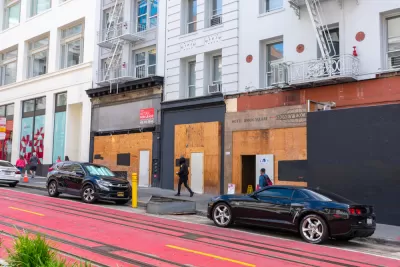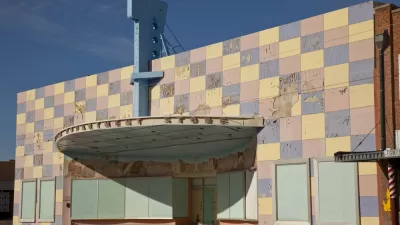As commercial storefronts experience high vacancy rates, cities like Oakland and San Francisco are making concerted efforts to support temporary tenants, public art installations, and small entrepreneurs that can revitalize abandoned spaces.

As stories from around the country attest, the last two and a half years accelerated a hollowing-out of central business districts in many U.S. cities. Regardless of how quickly the pandemic officially ends, writes John King in a paywalled article in the San Francisco Chronicle, “What cities and building owners must do now is find intriguing, inventive ways to plug holes on a short-term basis — so that today’s terrain of ‘for rent’ signs doesn’t become a permanent blight on too many urban blocks.”
King argues that “Cities need to find ways to prime the pump, and facilitate new types of ongoing activities within otherwise vacant ground floor spaces.” Kate Sofis, director of the San Francisco Office of Economic and Workforce Development, agrees. As King writes, “One promising initiative comes out of Sofis’ office: ‘Vacant to Vibrant,’ which would allocate $750,000 in the 2022-23 city budget to ‘pairing property owners with artists and small businesses who can use the space for short term activations.’”
King imagines even more possibilities: “Imagine if civic or cultural institutions committed to programming a year of exhibitions in a spacious storefront near Salesforce Tower, one after the other, each showcasing a niche within their collection.” Or “City Hall itself could commit to a storefront that would function as a service center — an easy spot for residents to get assistance face to face.”
“It also makes sense to loosen the definition of what is allowed along could-be-busy sidewalks,” King writes, pointing to the city of Oakland’s experiment in doing just that. Across the bay, “San Francisco’s proposed budget next year includes $2.5 million for special events and streetscape improvements in what the city calls the ‘economic core.’ The goal: to ‘draw a wide range of both business and leisure visitors over the course of a week.’ And give them a reason to stop by more than once.”
FULL STORY: Can pop-ups save downtown San Francisco? How Bay Area cities are trying to revive empty storefronts

Alabama: Trump Terminates Settlements for Black Communities Harmed By Raw Sewage
Trump deemed the landmark civil rights agreement “illegal DEI and environmental justice policy.”

Study: Maui’s Plan to Convert Vacation Rentals to Long-Term Housing Could Cause Nearly $1 Billion Economic Loss
The plan would reduce visitor accommodation by 25% resulting in 1,900 jobs lost.

Planetizen Federal Action Tracker
A weekly monitor of how Trump’s orders and actions are impacting planners and planning in America.

This Toronto Suburb Has More Bus Riders Than Columbus, Ohio
Brampton, Ontario used gradual improvements in service to prove that if you build it, they will ride.

Paris Bike Boom Leads to Steep Drop in Air Pollution
The French city’s air quality has improved dramatically in the past 20 years, coinciding with a growth in cycling.

Why Housing Costs More to Build in California Than in Texas
Hard costs like labor and materials combined with ‘soft’ costs such as permitting make building in the San Francisco Bay Area almost three times as costly as in Texas cities.
Urban Design for Planners 1: Software Tools
This six-course series explores essential urban design concepts using open source software and equips planners with the tools they need to participate fully in the urban design process.
Planning for Universal Design
Learn the tools for implementing Universal Design in planning regulations.
Smith Gee Studio
Alamo Area Metropolitan Planning Organization
City of Santa Clarita
Institute for Housing and Urban Development Studies (IHS)
City of Grandview
Harvard GSD Executive Education
Toledo-Lucas County Plan Commissions
Salt Lake City
NYU Wagner Graduate School of Public Service





























